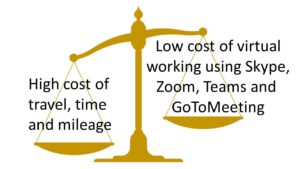After hosting a business continuity planning webinar in March, the week the country was locked down and businesses were asked to work from home, rapid change in virtual working practices was already starting.
Many independent therapists and case managers are realising the amazing benefit of using Zoom, Skype, GoToMeeting, Teams and other platforms for carrying out their client one-to-one sessions, MDT meetings and new enquiry meet and greet conference calls. One occupational therapist said she felt the session was even better as it felt more concentrated, with the client looking at the screen with his headphones, directly listening to the instructions.
It will be interesting to see the impact on remote working activities as this becomes the norm for a number of weeks while we work from home with very little face-to-face interaction.
The cost of travel and the time impact on client visits
Will personal injury solicitors and insurance companies start to see the economic impact of providing communication, support and guidance to clients remotely as a strong positive, a good way of saving money for clients?
But will the cost of travel, time and mileage be seen as a negative impact on therapists and case managers who will lose out on these costs as part of their visits to see clients? As we all know, sometimes the travel and mileage cost can outweigh the cost of the actual therapy session.
Getting creative
Occupational therapists are often seen as creative, imaginative and resourceful people, having to do a lot of problem solving and dealing with so many different aspects of a client’s life. This may be a perfect opportunity for pushing boundaries, making use of their talents and developing new ideas and ways of communicating remotely with their clients.
I have seen a great YouTube video of a physiotherapist recording themselves in their home living rooms showing how to carry out therapy exercises, used to share with a client for their rehabilitation. Surely, this has to be much more interactive, visual and easy for the client to mirror and watch over and over again.
Interesting times ahead – what working habits will we adapt to and keep going forward?
